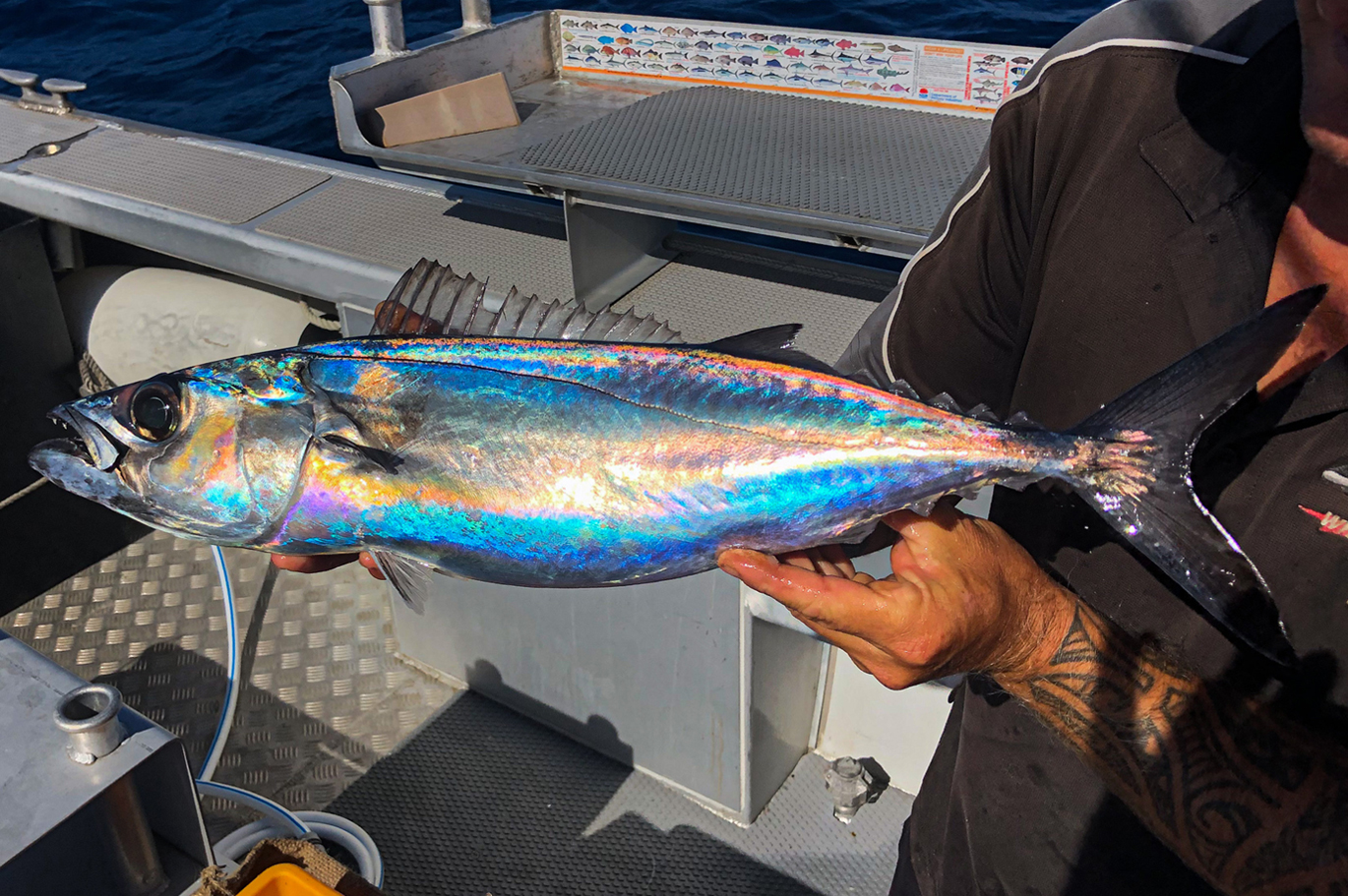Tonga Escolar, Tongaichthys robustus Nakamura & Fujii 1983

A Tonga Escolar, Tongaichthys robustus, from north of Lord Howe Island in the Tasman Sea, depth 300 m, November 2019. Source: @tukula / iNaturalist.org. License: CC By Attribution-NonCommercial
A semifusiform, robust escolar with a large head, a large eye, a single relatively straight or slightly undulating lateral line, well-developed pelvic fins, and one or two small fangs in the upper jaw. The Tonga Escolar lacks obvious keels on the caudal peduncle and an abdominal keel along the ventral midline of the belly.
Tonga Escolar, Tongaichthys robustus Nakamura & Fujii 1983
More Info
|
Distribution |
Flinders Reef in the Coral Sea off Queensland, to Lord Howe Island in the Tasman Sea. This poorly known species inhabits seamounts, ridges and rises in depths to about 350 m. |
|
Features |
Dorsal fin XVI-XVII, 14-17 + 5-6 finlets; Anal fin I, 14-16 + 5-6 finlets; Pectoral fin i, 16-18; Pelvic fin I, 5; Caudal fin principal rays 19; Gill rakers 4-6+ 1 + 7-11); Branchiostegal rays 7; Vertebrae 18+15=33. Body semifusiform, slightly compressed, body depth 4.2-4.5 times into standard length; head length 3.2 times into standard length; Snout short, rather blunt; eye large, closer to tip of snout than rear of gill cover; interorbital region flat with a V-shaped furrow posteriorly; operculum with a deep notch posteriorly; lower jaw protruding, both jaws without dermal processes; upper jaw with one or two (rarely three) pairs of small fang-like teeth, fang-like teeth absent from lower jaw; teeth present on vomer and palatines. Skin rather smooth, very small deciduous fine cycloid scales on body and postorbital region; cheek scales enlarged, elongated and overlapping; lateral line single, obvious, gradually descending from above upper margin of operculum to base of caudal fin with slight undulations, lateral line scales modified into incomplete tube-like structures. First dorsal fin moderately high, fin spines soft and weak, originating above anterior insertion of pectoral fin, base of first dorsal fin slightly longer than that of second dorsal fin (including finlets); folded fin fits into a moderately deep groove. Second dorsal fin rather low with 5 to 6 finlets posteriorly; dorsal and anal finlets triangular in shape. Anal fin rather low with a minute spine anteriorly and several finlets posteriorly. Pectoral fin small and situated rather low. Pelvic fin well developed and slightly shorter than pectoral fin, inserted below hind insertion of pectoral fin. Caudal-peduncle depth short, less than eye diameter. Caudal fin stout but rather small, a pair of keel-like processes slightly developed on caudal base. Soft fin rays of all fins segmented. |
|
Colour |
Dark brown dorsally, paler below. Dorsal portion of head, upper margin of lower jaw, inner base of pectoral fins and anterior margin of second dorsal fin darker. Highly iridescent in life. |
|
Fisheries |
A rare escolar that is of no interest to fisheries. |
|
Conservation |
|
|
Remarks |
The semifusiform body shape, large head with an expanded gill cavity, partly ossified gill rakers, and a moderately deep groove for the first dorsal fin suggests that the Tonga Escolar is a relatively fast-swimming predator. |
|
Etymology |
The specific name is from the Latin robustus (= robust, strong, hardy) in reference to the semifusiform and robust body of this species. |
|
Species Citation |
Tongaichthys robustus Nakamura & Fujii 1983, Publ. Seto Mar. Biol. Lab. 27(4/6): 174, figs. 2-12. Type locality: Tonga Ridge, southern Pacific, 22°10.8'S, 175°23.6'W, depth 312-288 m. |
|
Author |
Bray, D.J. & Schultz, S. 2019 |
|
Resources |
Tonga Escolar, Tongaichthys robustus Nakamura & Fujii 1983
References
Nakamura, I. & Fujii, E. 1983. A new genus and species of Gempylidae (Pisces: Perciformes) from Tonga Ridge. Publications of the Seto Marine Biological Laboratory 27(4/6): 173-191 http://hdl.handle.net/2433/176057
Nakamura, I. & Parin, N.V. 1993. FAO Species Catalogue. Snake mackerels and cutlassfishes of the world (families Gempylidae and Trichiuridae). An annotated and illustrated catalogue of the Snake Mackerels, Snoeks, Escolars, Gemfishes, Sackfishes, Domine, Oilfish, Cutlassfishes, Scabbardfishes, Hairtails, and Frostfishes known to date. Fisheries Synopsis No. 125, Vol. 15. Rome : FAO 136 pp. 200 figs.
Nakamura, I. & Parin, N.V. 2001. Gempylidae, Trichiuridae. pp. 3698-3720 in Carpenter, K.E. & Niem, T.H. (eds). The Living Marine Resources of the Western Central Pacific. FAO Species Identification Guide for Fisheries Purposes. Rome : FAO Vol. 6 pp. 3381-4218.



